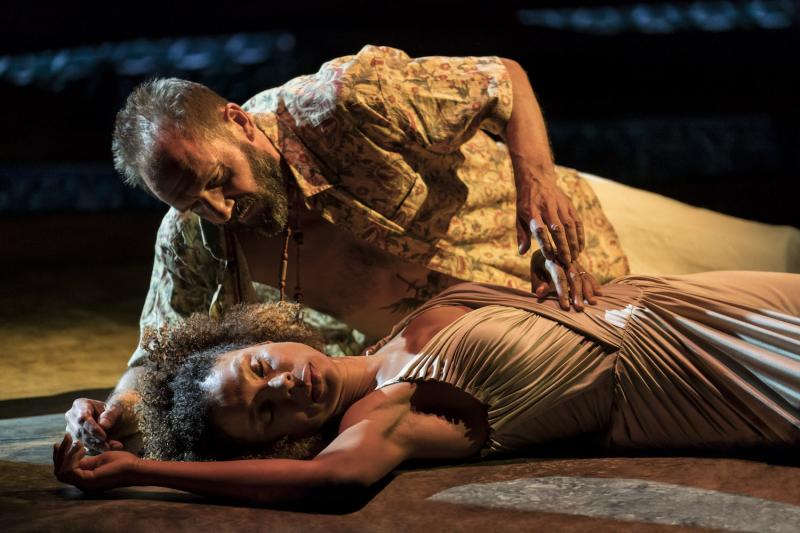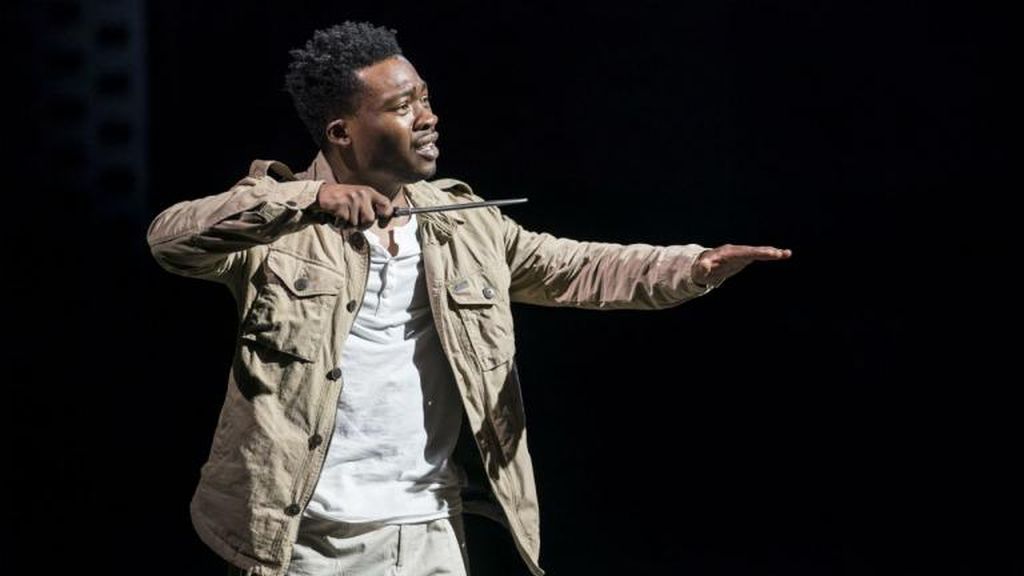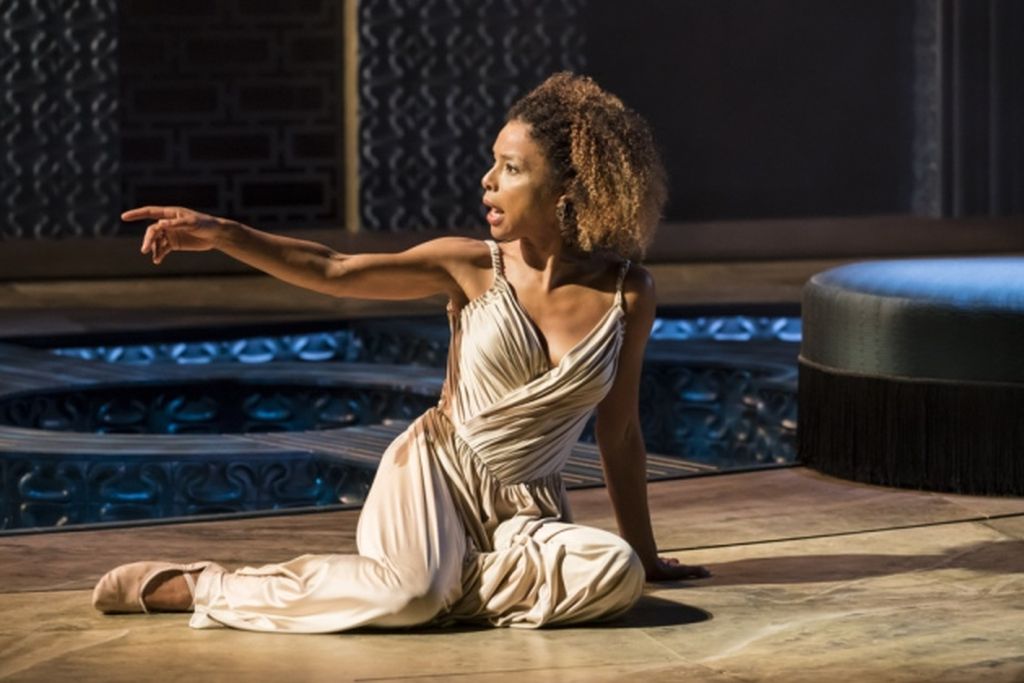Antony and Cleopatra, National Theatre at Home review – Fiennes and Okonedo triumph in dragging tragedy | reviews, news & interviews
Antony and Cleopatra, National Theatre at Home review – Fiennes and Okonedo triumph in dragging tragedy
Antony and Cleopatra, National Theatre at Home review – Fiennes and Okonedo triumph in dragging tragedy
A triumvirate of talent and a slick set can't in themselves speed things along

Like an asp eating its own tail, the National Theatre's 2018 production of Antony and Cleopatra, streaming on YouTube until 14 May, begins as it will end.
It's a neat trick for Godwin, a National semi-regular since 2013 now based much of the year in Washington DC; his Shakespeare debut at this address, the gloriously madcap Twelfth Night with Tamsin Greig, was part of the first round of NT At Home offerings, two weeks (or several decades) ago. This time, though, despite strong performances from both Okonedo and Ralph Fiennes in the lead roles, the show doesn't fully get going until the last 20 minutes. Which, across three hours, is something of an achievement.
 The fault is partly Shakespeare's: the plot of Antony and Cleopatra can be summarised in a few lines, and yet the Bard takes five acts to get through it. What continues to fascinate about the play isn't its action, but its eponymous heroes: lovers, rulers, the original celebrities. It's about image, how things look and seem, how the knowledge of being observed shapes what we do.
The fault is partly Shakespeare's: the plot of Antony and Cleopatra can be summarised in a few lines, and yet the Bard takes five acts to get through it. What continues to fascinate about the play isn't its action, but its eponymous heroes: lovers, rulers, the original celebrities. It's about image, how things look and seem, how the knowledge of being observed shapes what we do.
Thus the queen of Egypt must always look the part, and Okonedo does right up until that snake's loving bite, enrobed in Evie Gurney's gorgeous gowns. The sartorial homage to Beyoncé's "Lemonade" early in the first act is the cherry on top of a masterclass from this comparative Shakespearean newbie. Fisayo Akinade (pictured above, last seen in Armando Iannucci's David Copperfield), as Antony's sharp, tenderhearted aide Eros, is the third triumvir of great performances here. Fiennes and Okonedo (the latter pictured below) are magnificent, wholly convincing as these larger-than-life lovers. Cleopatra often overshadows her Antony – Shakespeare had a favourite child – but Fiennes more than holds his own, balancing bravado with aching vulnerability.
 There are moments of similar excellence among the rest of the 23-strong cast: Kasim's Caesar is particularly well-considered, showing a childlike disappointment in his one-time hero as he laments Antony's extended stay with Cleopatra. Obianyo and Landers are delightful, sparking off each other brilliantly in Act 1, smouldering into cast-iron grace after the interval. Ideally they would get their own spin-off, but Obianyo's stare-down with Kasim in Act 2 is a fair trade. Almost everybody else sounds like they're shouting all the time, which could more easily be blamed on the Olivier's proportions if Godwin hadn't directed there before. Every word is heavy with theatrical history, so much so that certain lines are lost.
There are moments of similar excellence among the rest of the 23-strong cast: Kasim's Caesar is particularly well-considered, showing a childlike disappointment in his one-time hero as he laments Antony's extended stay with Cleopatra. Obianyo and Landers are delightful, sparking off each other brilliantly in Act 1, smouldering into cast-iron grace after the interval. Ideally they would get their own spin-off, but Obianyo's stare-down with Kasim in Act 2 is a fair trade. Almost everybody else sounds like they're shouting all the time, which could more easily be blamed on the Olivier's proportions if Godwin hadn't directed there before. Every word is heavy with theatrical history, so much so that certain lines are lost.
Thank heavens, then, for set designer Hildegard Bechtler, who contrasts Egypt's fluid, shifting landscape with the solid, brittle marble of Rome, and spins one out of another as the play goes on, so we're never quite sure where we stand. The play's tragic majesty still shines from your laptop screen, helped along by Michael Bruce's twisting, sinuous score. Godwin's use of music can't be faulted: an unexpected yet effective dance sequence emphasises the keen knife-edge of violence over which these military men eventually tumble. The battle scenes are brought to frighteningly intense life thanks in no small measure to lighting and sound from Tim Lutkin and Christopher Shutt. But this late second wind is frustrating: another glimpse of a better production, perhaps, hiding underneath this one.
rating
Share this article
The future of Arts Journalism
You can stop theartsdesk.com closing!
We urgently need financing to survive. Our fundraising drive has thus far raised £49,000 but we need to reach £100,000 or we will be forced to close. Please contribute here: https://gofund.me/c3f6033d
And if you can forward this information to anyone who might assist, we’d be grateful.

Subscribe to theartsdesk.com
Thank you for continuing to read our work on theartsdesk.com. For unlimited access to every article in its entirety, including our archive of more than 15,000 pieces, we're asking for £5 per month or £40 per year. We feel it's a very good deal, and hope you do too.
To take a subscription now simply click here.
And if you're looking for that extra gift for a friend or family member, why not treat them to a theartsdesk.com gift subscription?
more Theatre
 Mary Page Marlowe, Old Vic review - a starry portrait of a splintered life
Tracy Letts's Off Broadway play makes a shimmeringly powerful London debut
Mary Page Marlowe, Old Vic review - a starry portrait of a splintered life
Tracy Letts's Off Broadway play makes a shimmeringly powerful London debut
 Little Brother, Soho Theatre review - light, bright but emotionally true
This Verity Bargate Award-winning dramedy is entertaining as well as thought provoking
Little Brother, Soho Theatre review - light, bright but emotionally true
This Verity Bargate Award-winning dramedy is entertaining as well as thought provoking
 The Unbelievers, Royal Court Theatre - grimly compelling, powerfully performed
Nick Payne's new play is amongst his best
The Unbelievers, Royal Court Theatre - grimly compelling, powerfully performed
Nick Payne's new play is amongst his best
 The Maids, Donmar Warehouse review - vibrant cast lost in a spectacular-looking fever dream
Kip Williams revises Genet, with little gained in the update except eye-popping visuals
The Maids, Donmar Warehouse review - vibrant cast lost in a spectacular-looking fever dream
Kip Williams revises Genet, with little gained in the update except eye-popping visuals
 Ragdoll, Jermyn Street Theatre review - compelling and emotionally truthful
Katherine Moar returns with a Patty Hearst-inspired follow up to her debut hit 'Farm Hall'
Ragdoll, Jermyn Street Theatre review - compelling and emotionally truthful
Katherine Moar returns with a Patty Hearst-inspired follow up to her debut hit 'Farm Hall'
 Troilus and Cressida, Globe Theatre review - a 'problem play' with added problems
Raucous and carnivalesque, but also ugly and incomprehensible
Troilus and Cressida, Globe Theatre review - a 'problem play' with added problems
Raucous and carnivalesque, but also ugly and incomprehensible
 Clarkston, Trafalgar Theatre review - two lads on a road to nowhere
Netflix star, Joe Locke, is the selling point of a production that needs one
Clarkston, Trafalgar Theatre review - two lads on a road to nowhere
Netflix star, Joe Locke, is the selling point of a production that needs one
 Ghost Stories, Peacock Theatre review - spirited staging but short on scares
Impressive spectacle saves an ageing show in an unsuitable venue
Ghost Stories, Peacock Theatre review - spirited staging but short on scares
Impressive spectacle saves an ageing show in an unsuitable venue
 Hamlet, National Theatre review - turning tragedy to comedy is no joke
Hiran Abeyeskera’s childlike prince falls flat in a mixed production
Hamlet, National Theatre review - turning tragedy to comedy is no joke
Hiran Abeyeskera’s childlike prince falls flat in a mixed production
 Rohtko, Barbican review - postmodern meditation on fake and authentic art is less than the sum of its parts
Łukasz Twarkowski's production dazzles without illuminating
Rohtko, Barbican review - postmodern meditation on fake and authentic art is less than the sum of its parts
Łukasz Twarkowski's production dazzles without illuminating
 Lee, Park Theatre review - Lee Krasner looks back on her life as an artist
Informative and interesting, the play's format limits its potential
Lee, Park Theatre review - Lee Krasner looks back on her life as an artist
Informative and interesting, the play's format limits its potential
 Measure for Measure, RSC, Stratford review - 'problem play' has no problem with relevance
Shakespeare, in this adaptation, is at his most perceptive
Measure for Measure, RSC, Stratford review - 'problem play' has no problem with relevance
Shakespeare, in this adaptation, is at his most perceptive

Add comment